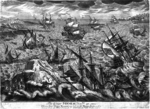Froxfield and Privett

Froxfield and Privett is a civil parish in East Hampshire, England, about 3 miles (5 km) northwest of Petersfield. The settlements in the parish are the villages of Froxfield Green, Privett and High Cross, and several hamlets including Bailey Green, Filmore Hill, Stoner Hill and Warren Corner. The population of the parish taken at the 2021 census was 929.The parish is on high ground, rising to over 800 feet (240 m) above sea level in the north, and separated from Petersfield by the steep slope of Stoner Hill. The western boundary of the parish follows the A32 Gosport-Alton road, and in the southwest corner the boundary follows the A272 Winchester-Petersfield road.A civil parish named Froxfield was created in the 19th century, and had an area (before it was enlarged to include Privett) of 4,909 acres (1,987 ha). The Basing Park estate lies in the north-west.Privett was anciently part of West Meon manor, and its church a chapelry of the church at West Meon. In the 19th century it became a civil parish, with an area of about 1,279 acres (518 ha). In 1932, the parish was abolished to enlarge Froxfield parish; its population had been recorded as 172 in 1931.In the 2010s, the name of the parish changed from Froxfield to Froxfield and Privett. In May 2013, East Hampshire District Council approved the same change of name for the parish council.
Excerpt from the Wikipedia article Froxfield and Privett (License: CC BY-SA 3.0, Authors, Images).Froxfield and Privett
Collywater Lane, East Hampshire Froxfield and Privett
Geographical coordinates (GPS) Address Nearby Places Show on map
Geographical coordinates (GPS)
| Latitude | Longitude |
|---|---|
| N 51.04 ° | E -1 ° |
Address
Collywater Lane
Collywater Lane
GU34 3PJ East Hampshire, Froxfield and Privett
England, United Kingdom
Open on Google Maps








